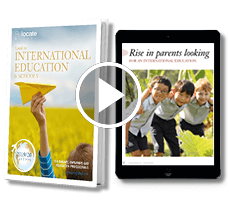Rise in parents looking for an international education
More aspirational parents than ever are looking for an English-medium international education for their child, helping to fuel growth and economies particularly in Asia and the Middle East.
Today, according to data from ISC Research, 5.6 million children aged between 3 and 18 are attending English-medium international schools around the world. 19 years ago (in the year 2000), there were just 969,000 children learning in these schools. The number of international schools has increased more than fourfold in that time from 2,584 to 10,937.
The 2019 ISC Research Global Opportunities Report on the world's international schools’ market, published in August, shows current demand, supply and local fluctuations.
Fees and school numbers in key cities
School fees vary significantly by country. In China, the average annual fees for a child to attend an international school are currently USD $15,726, compared to $8,073 in the UAE, and $6,395 in Malaysia. In some cities today, the choice of international schools for families is extensive. In Dubai there are now 309 international schools, Shanghai has 168 international schools, Abu Dhabi has 164 international schools, Beijing has 151 international schools and Doha has 144 international schools. The growing number of schools means more visibility of their existence to more families, more choice for parents, and more competition between the schools.
In some cities today, the choice of international schools for families is extensive. In Dubai there are now 309 international schools, Shanghai has 168 international schools, Abu Dhabi has 164 international schools, Beijing has 151 international schools and Doha has 144 international schools. The growing number of schools means more visibility of their existence to more families, more choice for parents, and more competition between the schools.Demand in Asia
Demand for international education is particularly high in Asia where it has become an aspiration for a large number of wealthier families. In the four years from January 2015 to 2019, Eastern Asia has experienced an average annual student enrolment growth rate of 7.4%, increasing from 452,400 students to 600,900. South-Eastern Asia has seen a 5.7% average growth rate, from 394,100 students in 2015 to 492,300 this year. And enrolment in Western Asia (the Middle East including Egypt) has grown from 1,334,100 in 2015 to 1,597,200 today.Related articles:
- Chinese applicants to UK universities hit new high
- International Schools – What global mobility experts need to know
- Numbers of international schools continue to rise
22 new international schools have opened in the United Arab Emirates in the past two years and most of the recent development has been in the mid-market sector where annual school fees are more affordable to a wider range of parents. In China, where international schools accessible to expatriate children are segmented from those that Chinese nationals can attend, it is the schools for local Chinese children that have experienced most growth. Today 359,300 children in China attend the 884 international schools there and 66% of them are Chinese nationals.As more parents realise the international school options accessible to them, so demand will continue to rise.
According to ISC Research, several countries are expected to see significant new international school development in the near future. These include:
- Saudi Arabia, where education is an emerging sector for foreign investment
- Qatar, which is likely to attract new international school development in the coming years stimulated by its National Vision for 2030
- Malaysia, where several areas are experiencing industrial and residential growth and which are currently limited in international school provision
- Vietnam which, as a result of legislation change (the enrolment cap for local students at international schools has been increased), will be able to admit more local children into international schools
- Japan, where new immigration laws and market confidence are encouraging an influx of expatriates
ISC Research has been producing data and providing trends, intelligence and expertise on the world's English-medium international schools market for 25 years. More information about the market is available at https://www.iscresearch.comThis article is from Relocate Global's Guide to International Education & Schools 2019/20 which is packed with expert tips and information for those relocating and the professionals supporting them. For volume options, co-branded editions, digital or online licence agreements and advertising opportunities, contact Fiona Murchie at +44 (0)1892 891334 or email fiona@relocatemagazine.com
Now available as an ebook on Amazon! Simply download from Amazon onto your Kindle, mobile phone or tablet to read wherever you are!
Subscribe to Relocate Extra, our monthly newsletter, to get all the latest international assignments and global mobility news.Relocate’s new Global Mobility Toolkit provides free information, practical advice and support for HR, global mobility managers and global teams operating overseas.
 Access hundreds of global services and suppliers in our Online Directory
Access hundreds of global services and suppliers in our Online Directory For more education and school-related news, visit our Education and Schools pages.© 2019. This article first appeared in the 2019/20 edition of the Guide to International Education & Schools published by Relocate Global, Spray Hill, Hastings Road, Lamberhurst, Kent TN3 8JB. All rights reserved. This publication (or any part thereof) may not be reproduced in any form without the prior written permission of Relocate Global. Relocate Global accepts no liability for the accuracy of the contents or any opinions expressed herein.
For more education and school-related news, visit our Education and Schools pages.© 2019. This article first appeared in the 2019/20 edition of the Guide to International Education & Schools published by Relocate Global, Spray Hill, Hastings Road, Lamberhurst, Kent TN3 8JB. All rights reserved. This publication (or any part thereof) may not be reproduced in any form without the prior written permission of Relocate Global. Relocate Global accepts no liability for the accuracy of the contents or any opinions expressed herein.©2025 Re:locate magazine, published by Profile Locations, Spray Hill, Hastings Road, Lamberhurst, Kent TN3 8JB. All rights reserved. This publication (or any part thereof) may not be reproduced in any form without the prior written permission of Profile Locations. Profile Locations accepts no liability for the accuracy of the contents or any opinions expressed herein.






































